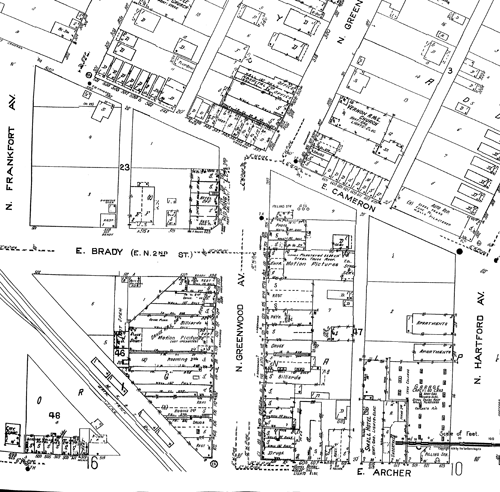Greenwood Gap Theory: Tulsa's Green Book places weren't destroyed in 1921
A story published Monday by public radio station KGOU is another prime specimen of the cognitive dissonance that is the "Greenwood Gap Theory" -- the misconception that Tulsa's African-American neighborhood was never rebuilt after what is commonly known as the 1921 Race Riot (but more accurately described as a massacre).
"How Curious: Where Were Oklahoma's Green Book Listings" is the latest edition in KGOU's series of feature stories in response to listener questions. This year's winner of the Oscar best picture has called public attention to the annual series of guidebooks for African-American motorists, letting readers know where their business would be welcome in the days of Jim Crow segregation. According to the KGOU story, the Green Book was first published in 1936; the last edition was for 1966-67.
Oklahoma was first included in 1939. Remember that date. We'll come back to it.
The article paints a lively portrait of Oklahoma City's "Deep Deuce" district, where many of the businesses listed in the Green Book were located. N. E. 2nd Street was the commercial hub of the African-American community. There are a few pictures of businesses that are still standing today.
But what about Tulsa? Claire Donnelly writes:
In Oklahoma City and Tulsa, very few addresses listed in The Green Book are still standing.Many of Tulsa's listings were centered around the city's Greenwood District, which was looted and burned by white rioters in June 1921. According to the Tulsa Historical Society, 35 city blocks were destroyed and as many as 300 people may have died.
While those sentences are true, their juxtaposition suggests a causation that is impossible in the absence of time travel. The Green Book businesses, which were there in the 1930s, 1940s, 1950s, and 1960s, are gone, not because of the riot, but because of urban renewal and expressway construction in the late 1960s: The "Model Cities" program, part of LBJ's "War on Poverty," and the construction of the north leg of the Inner Dispersal Loop, which cut through the heart of the Deep Greenwood commercial district.
Here's an excerpt from the 1939 Sanborn Fire Insurance Map, showing Greenwood as it would have been the first year Oklahoma was mentioned in the Green Book.

I can't get too upset with Ms. Donnelly: She links to the New York Public Library's online collection of Green Book editions and to a spreadsheet collating all of the Oklahoma Green Book listings, which (I surmise) she assembled herself -- a very handy resource.
Based on the spreadsheet, these are the Tulsa Green Book listings still standing. Keep in mind that street numbers may shift over time; I'm going by the numbering on the Sanborn map. The spreadsheet has the year of each individual book in which the business appeared; I've summarized with a range.
- Cotton Blossom Beauty Parlor, 106 N. Greenwood, 1939-1941.
- Art's Chili Parlor, 110 N. Greenwood, 1950-1961. (The Bryant Building.)
- Mrs. W. H. Smith Tourist Home, 124 1/2 N. Greenwood, 1939-1962. (Now the second story above Fat Guy's Burger Bar.)
- Maharry Drugs, 101 N. Greenwood, 1939-1955. (Northeast corner of Greenwood and Archer.)
- Vaughn Drugstore, 301 E. 2nd St., 1939. (Now Yokozuna.)
- Mince Service Station, 2nd & Elgin, 1939-1954. (NW corner, 325 E. 2nd. Red's Bar, formerly Dirty's Tavern and Woody's Corner Bar.)
- Lincoln Lodge, 1407 1/2 E. 15th St., 1941. (Aquarian Age Massage.)
The latter three are surprising, because they are outside the Greenwood District, in areas that might have been considered off-limits to African Americans. Association with the Green Book should add to the historic importance of these buildings.
Another location of note is the Avalon Motel at 2411 E. Apache St., on the northeast corner of Apache and Lewis, listed from 1954 to 1962. Before completion of the Gilcrease Expressway, this stretch of Apache was part of State Highway 11, which began at 51st and Memorial, headed north to Apache at the edge of the airport, then west to Peoria, and north to Turley, Sperry, and Skiatook. The motel, a simple one-story, park-at-your-door accommodation, was still there within my memory, but the site has been vacant for at least a decade. While many motels were built along US 66 around the same time, this appears to be the only motel catering to black tourists.
A concluding thought on the Greenwood Gap Theory: While it's easy to jump to the conclusion that Greenwood was never rebuilt after 1921 -- in the absence of city directories, aerial photography, Sanborn maps, and now the Green Book -- I suspect that the misconception has persisted in part because the civic leaders who were responsible for the second destruction of Greenwood in the 1960s and 1970s were still active in the community until not that many years ago and would have been quite happy to avoid any public blame for their decisions. Easier to remain quiet and let the folks sitting across the foundation boardroom table blame 1921 racists for the demolitions you promoted and approved.
MORE: You can find my omnibus overview of Greenwood's history, with links to further articles, images, and films, here.
UPDATED 2019/05/06, with a correction from Mike McUsic regarding Mince's Service Station. He provided a photo of a 1942 telephone directory listing Mince's at 325 E 2nd Street. McUsic will be leading walking tours of the Green Book locations in the Greenwood District on June 8th at 10:00 am and 3:00 pm, and on June 15th at 10:00 am. Tickets are $15, available via Eventbrite. McUsic has developed the Green Book Travelers HistoryPin site, locating 1,900 Green Book locations across the country, with names, descriptions, and historic and present-day photos. This link will take you to locations specific to Greenwood.
0 TrackBacks
Listed below are links to blogs that reference this entry: Greenwood Gap Theory: Tulsa's Green Book places weren't destroyed in 1921.
TrackBack URL for this entry: https://www.batesline.com/cgi-bin/mt/mt-tb.cgi/8470